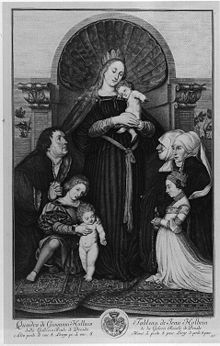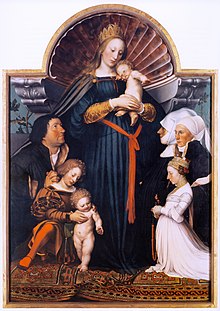Dresden Holbein dispute


The term Dresdner Holbeinstreit denotes an art-historical debate that was conducted in the 19th century on a pictorial theme by Hans Holbein the Younger . The form of the scientific discussion, the arguments and the result of this discourse are considered to be a turning point in the development of the still young discipline of “ art history ”, which began at the latest in the mid-19th century, “was fed by a literary-sentimental, foreign sources , ie a non-art perspective ”( Udo Kultermann ) to an independent science with specific methodology and to emancipate objectifiable results.
The dispute
The so-called " Madonna of Mayor Meyer " shows the Madonna with the child and the family of the Basel founder Jakob Meyer zum Hasen and exists in two versions: A painting, the original by Hans Holbein the Elder. J. from 1526, is part of the Würth Collection and is exhibited in the Johanniterkirche (Schwäbisch Hall). A copy by the painter Bartholomäus Sarburgh from the 17th century is in the Dresden Old Masters Picture Gallery . Both paintings have an eventful history and have passed through the hands of many owners over the centuries.
When the Huguenot art dealer Christoph Le Blon came into possession of the original Holbein picture in 1633, he had it copied by Sarburgh before reselling it and also sold the copy to Maria von Medici under the name Holbein . From then on, two pictures of the same name were circulating in European art collections.
In the 18th century, the copy was acquired in Venice for the collection of Elector Friedrich August II of Saxony and has since hung as a celebrated original by the German painter Holbein next to the showpiece of the Italian school, the Sistine Madonna by Raphael in Dresden. In 1822 the real Holbein also came to Germany, in the Berlin collection of Prince Wilhelm of Prussia . From then on, the art scholars argued about how these two images relate to each other.
After art historians had repeatedly traveled to Darmstadt, where the original had been since 1851, and Dresden to examine the pictures and compare them in memory, an exhibition was organized in Dresden in 1871 in which the two pictures were hung next to each other. At the same time, a congress was held with the leading art historians of the time. The result of the congress was announced on September 5, 1871: The Darmstadt Madonna is the original by Holbein, the Dresden picture is clearly a copy. The result came about with the help of the newly developed style criticism , which no longer used intuitive impressions and subjective or time-bound concepts of beauty as a basis for viewing the image, but rather exact comparisons of formal image values.
Investigations using X-rays and infrared later confirmed the finding that the Darmstadt painting had been changed several times and corresponded with the chalk studies that had been preserved, while the Dresden picture only reproduces the last version of the Darmstadt picture. As a result, Emil Major attributed the Dresden painting to the painter Bartholomäus Sarburgh in 1910 and dated the creation to between 1635 and 1637.
The original was in Darmstadt until 2004, then on loan in Frankfurt am Main. It has been part of the Würth Collection since 2011 and has been on display in Schwäbisch Hall since the beginning of 2012 .
Participating art historians at the 1871 Congress
- Adolf Bayersdorfer
- Wilhelm von Bode
- Friedrich Lippmann
- Wilhelm Luebke
- Carl von Lützow
- Gerhard Malß
- Bruno Meyer
- Moritz Thausing
- Alfred Woltmann
- Karl Woermann
- Albert von Zahn
literature
- Gustav Theodor Fechner : About the question of authenticity of Holbein's Madonna. 1871.
- Hans Holbein's Madonna in the Städel. The mayor, his painter and his family. Catalog for the exhibition in the Frankfurt Städel 2004. Petersberg 2004, ISBN 3-937251-24-3 .
- Udo Kultermann : The Dresden Holbeinstreit. In: Udo Kultermann: History of Art History. The way of a science. Prestel Verlag, Munich 1996, ISBN 3-7913-1056-9 , pp. 136-141.
- Bernhard Maaz: Hans Holbein the Younger The Madonnas of Mayor Jacob Meyer zum Hasen in Dresden and Darmstadt: Perception, finding and obscuring the truth. Swiridoff-Verlag, Künzelsau 2014, ISBN 978-3-89929-289-3 .
Individual evidence
- ^ The artist and art dealer Christoph le Blon in the database of the RKD - Nederlands Instituut voor Kunstgeschiedenis
